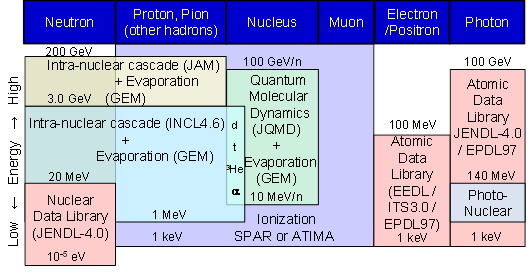
| Physical Models > Map of Models | |
|---|---|
Note: The followings are description for PHITS2.64! Above figure summarizes the physics models recommended for use in PHITS for simulating nuclear and atomic collisions. The intra-nuclear cascade models JAM [1] and INCL4.6 [2] are employed for simulating the dynamic stage of hadron-induced nuclear reactions in the high and intermediate energy regions, respectively. Other intra-nuclear cascade models, such as INC-ELF [3] and a modified version of BERTINI [4], can be also selected in this region. On the other hand, the quantum molecular dynamics model JQMD [5] is generally employed for nucleus-induced reactions, because consideration of the nuclear forces between every combination of nucleons is very important in the simulation. Simulations for deuteron-, triton-, 3He-, and -induced reactions at intermediate energies are the exceptional cases where INCL4.6 is recommended to be employed, because INCL4.6 can deal with light-ion induced reactions and is much faster than JQMD. The evaporation and fission model GEM [6] is adopted for simulating the static stage for both hadron- and nucleus-induced reactions. The energy losses of charged particles, except for electrons, are calculated using the SPAR [7] or ATIMA [8] codes with the continuous slowing down approximation. Nuclear and atomic data libraries are generally used for simulating low-energy neutron-induced nuclear reactions and photo- and electro-atomic interactions, respectively. These data libraries are written in the ACE format, which is the same format as that adopted in MCNP [9], but different from that of original evaluated-data files, such as JENDL-4.0 [10]. Thus, it is necessary to develop PHITS-readable data libraries by compiling the original evaluated-data files using nuclear data processing systems such as NJOY99 [11]. The neutron and photon data libraries included in the PHITS package were compiled from JENDL-4.0 and its sub-library based on EPDL97 [12], respectively. The electron library was developed based on EEDL [13] and ITS3.0 [14], in addition to EPDL97. Photo-nuclear reactions can be treated only for the lower energy regions in which the giant resonance is the dominant reaction mechanism. The highest energies of particles recommended to be simulated using PHITS are 200 GeV for hadrons, 100 GeV/n for nucleus, 100 MeV for electrons and positrons, and 100 GeV for photons. Note that PHITS can deal with the transport of particles above these energies, but the accuracy of simulations for such high-energy particles has not been validated. On the other hand, the lowest particle energy that can be simulated using PHITS is 1 keV, except for neutrons, because the continuous slowing down approximation cannot be applied to the transport simulation of charged particles below this energy. Event-by-event analysis of each ionization is necessary for such low-energy particle transport simulation, but this process is not incorporated in PHITS because of its long computational time. Thus, the minimum spatial resolution reliably achieved by PHITS simulations is approximately 10-4 g/cm2, e.g. 1 micron in liquid water. For neutrons, PHITS can handle transport down to 10-5 eV using the neutron data library. Reference
|
